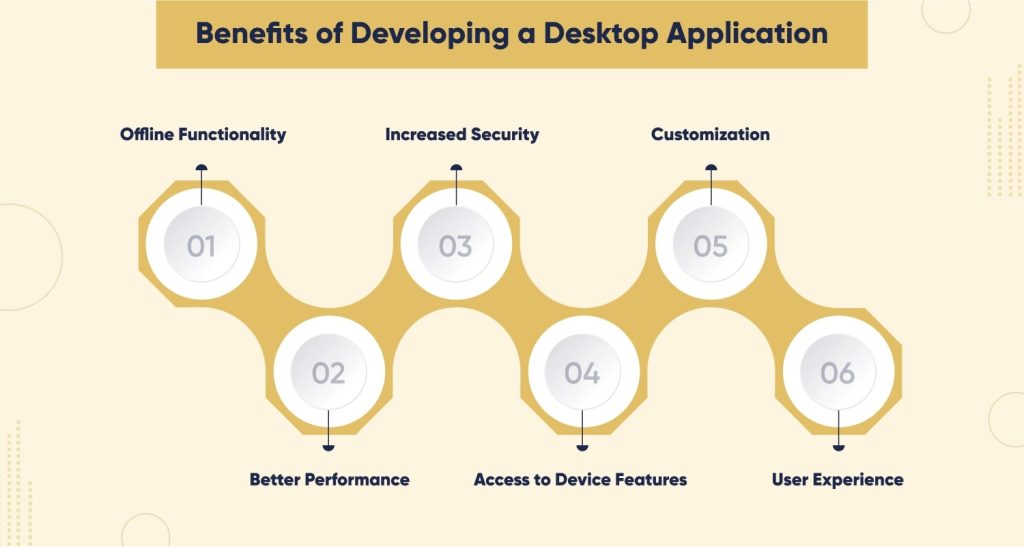Desktop Application
A Desktop Application is a software program designed to run locally on a desktop or laptop computer, utilizing the device’s resources to perform specific tasks for users
[j21u58]
[lbsg4h]
. Its significance lies in its ability to offer reliable, high-performance solutions independent of internet connectivity—making it vital for individuals and organizations that require secure, robust computing environments.

Main Content
At its core, a desktop application operates directly within a user’s operating system (such as Windows, macOS, or Linux), providing functionality ranging from word processing and graphic design to banking and data analysis
[j21u58]
[lbsg4h]
. Unlike web applications that depend on browsers and remote servers, desktop applications are installed locally. This independence allows them greater access to hardware resources (CPU, memory) and deeper integration with the system.
Practical examples include:
- Microsoft Word (document editing)
- Adobe Photoshop (image manipulation)
- QuickBooks Desktop (accounting management)
- Custom business solutions like bank account management tools
These applications serve various real-world purposes:
- Managing personal finances
- Processing complex data sets
- Running video games
- Accessing proprietary enterprise information without risking exposure over the internet [j21u58]

Key benefits of desktop applications include:
- Full control: Users can operate programs even during network outages; no reliance on web connectivity means greater uptime.
- Robust security: Sensitive information remains stored locally rather than transmitted over potentially vulnerable networks—a priority for businesses managing confidential data [j21u58] .
- Customization: Programs can be tailored easily for specific workflows without changing foundational architecture.
Potential applications span industries such as healthcare (medical records management), law (case documentation), education (e-learning platforms), finance (payroll systems), and creative arts. They automate repetitive tasks through features like OCR document processing and RPA tools that handle email responses or claims checking—enhancing productivity while minimizing human error
[eaos85]
.
However, challenges exist. Desktop apps can be resource intensive—consuming significant storage or memory—and may face compatibility issues across different operating systems. Updates usually require manual installation by users rather than seamless cloud delivery found in web-based alternatives. Ensuring cross-platform support adds complexity for developers as well
[s00hhe]
.
Current State and Trends
Despite the growth of mobile and cloud technologies, desktop applications remain widely adopted by both consumers and enterprises due to their reliability for mission-critical operations such as financial reporting or graphics rendering
[j21u58]
. Leading players in this space include Microsoft with Office Suite products; Adobe with Creative Cloud offerings; Intuit’s QuickBooks; along with countless industry-specific vendors.
Recent developments have focused on improving integration between local desktops and virtual environments—for instance through Virtual Desktop Infrastructure (VDI) which enables remote access while retaining administrative control over sensitive business functions. VDI adoption illustrates how traditional desktops evolve alongside cloud infrastructure demands by offering secure accessibility from anywhere—a trend especially relevant given rising BYOD (“Bring Your Own Device”) practices in modern workplaces
[7a8s8r]
.
Technologies shaping today’s landscape also encompass frameworks supporting cross-platform development—such as Electron—which allow developers to build one application that runs seamlessly across multiple operating systems.

Future Outlook
Looking ahead, advances in virtualization technology will continue blurring lines between local desktops and cloud services. The fusion of AI-driven automation into desktop software will further boost productivity while enhancing customization options tailored precisely for user needs. Security enhancements—including biometric authentication—and streamlined update mechanisms are expected to make these platforms even more attractive amid rising concerns about privacy breaches.
Conclusion
In summary, a Desktop Application remains an indispensable tool bridging high performance with security-focused independence. As technology evolves toward hybrid models combining local strength with cloud flexibility, these solutions will continue powering essential workflows across industries—with innovation poised at their core.
[j21u58]
[7a8s8r]
Citations
[j21u58] 2025, Aug 13. How to Make a Desktop Application? A Detailed Guide - Radixweb. Published: 2025-08-14 | Updated: 2025-08-14
[lbsg4h] 2025, Jun 20. Application Software: Types and What is Software Basics. Published: 2025-07-31 | Updated: 2025-06-21
[eaos85] 2025, Aug 28. Types of Application Software: A Detailed guide - Fingent. Published: 2025-08-18 | Updated: 2025-08-29
[7a8s8r] 2025, Aug 22. VDI Use Cases: Top 6 Real World Benefits and Applications. Published: 2025-08-21 | Updated: 2025-08-23
[s00hhe] 2025, Jul 31. The Difference Between Software and Application: Explained. Published: 2025-08-01 | Updated: 2025-08-01
(2025-08-29T04:38.376Z)
Perplexity Query
(2025-08-29T04:38
.376Z)
Question:
Write a comprehensive one-page article about "Desktop Application".
Structure the article as follows:
- Introduction (2-3 sentences)
- Define the term and its significance
- Provide context for why it matters
- Main Content (3-4 paragraphs)
- Explain the concept in detail
- Include practical examples and use cases
- Discuss benefits and potential applications
- Address any challenges or considerations
- Current State and Trends (1-2 paragraphs)
- Discuss current adoption and market status
- Mention key players or technologies
- Highlight recent developments
- Future Outlook (1 paragraph)
- Predict future developments
- Discuss potential impact
- Conclusion (1-2 sentences)
- Summarize key points
- End with a forward-looking statement
Important Guidelines:
- Keep the total length to approximately one page (500-800 words)
- Use clear, accessible language
- Include specific examples and real-world applications
- Make it engaging and informative for a general audience
- Use markdown formatting for structure
Replace "Desktop Application" with the actual vocabulary term in the prompt.
Image References:
Please include the following image references throughout your response where appropriate:
- [IMAGE 1: Relevant diagram or illustration related to the topic]
- [IMAGE 2: Practical example or use case visualization]
- [IMAGE 3: Additional supporting visual content] Model: sonar-pro